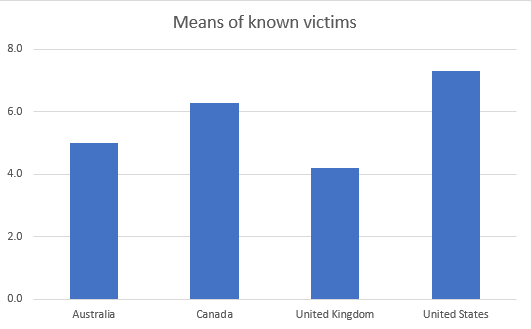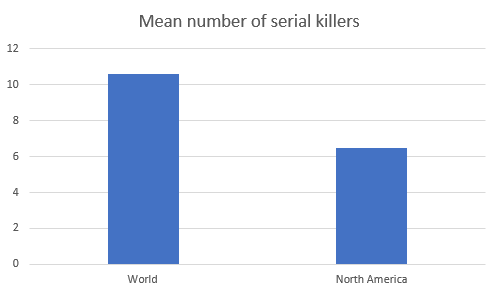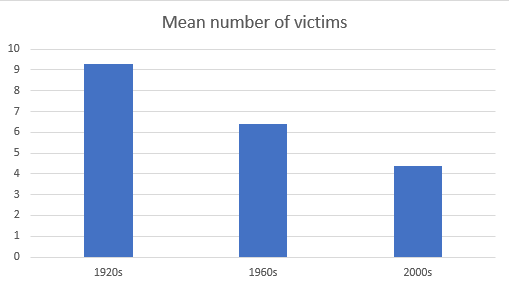Chapter 12. Serial Killers: Everything Up to One-Way Between-Groups ANOVA
Introduction
Serial Killers: Everything Up to One-Way Between-Groups ANOVA
By Marsha J. McCartney, University of Kansas, and Susan A. Nolan, Seton Hall University
List of serial killers by number of victims. (n.d.). In Wikipedia. Retrieved October 18, 2015, from https://en.wikipedia.org/wiki/List_of_serial_killers_by_number_of_victims
Introduction
Serial Killers: Everything Up to One-Way Between-Groups ANOVA
Admit it—at some point, you’ve probably been fascinated by the story of a serial killer and tried to understand why they are motivated to kill. It might have been someone fictional, like Hannibal Lector or Dexter, or someone in real life, like Jeffrey Dahmer or Ted Bundy. Their utter disregard for life is horrifying, but thankfully serial killers are extremely rare.
If you want to learn more, Wikipedia has a fairly comprehensive listing of serial killers that have been active from around 1900 to today: https://en.wikipedia.org/wiki/List_of_serial_killers_by_number_of_victims. This page lists the serial killers' names, the countries they are associated with, the years in which they were active, the number of known victims, and the number of possible victims. This is a goldmine of data for someone interested in learning more about serial killers—or someone who likes doing statistical analyses!
Example 1 of 4
Serial Killers: Everything Up to One-Way Between-Groups ANOVA
It is Halloween night. You and your roommates stay in for a horror movie marathon about serial killers. You watch Scream, American Psycho, Se7en, and Nightmare on Elm Street. You all have a great time getting scared and laughing with each other, but around 3 am you notice that everyone except you has fallen asleep during the last movie. And now there is no way you’re falling asleep. There are shadows and noises, which you hope are harmless, but you turn on every light in your apartment anyway. You decide to find out how likely it is that a serial killer could be active near you by looking at the Wikipedia data.
Let’s compare the mean numbers of known victims of serial killers across countries in which the primary language is English. The data include the numbers of known victims for each serial killer, as well as the country in which the murders took place. So, we can calculate means for a sample of the serial killers in each country. We’ll compare the mean for the samples of serial killers from Australia, Canada, the United States, and the United Kingdom.

The mean numbers of known victims of serial killers across primarily English-speaking countries, Image Long Description
| Australia | 5.0 |
| Canada | 6.3 |
| United Kingdom | 4.2 |
| United States | 7.3 |
Example 1 of 4
Serial Killers: Everything Up to One-Way Between-Groups ANOVA
What analysis could be used to see if there are significant differences in the mean numbers of victims of serial killers in Australia, Canada, the United States, and the United Kingdom?
Question
1XBn5JBSZq5SX9g7lflnT9vsNpiqVMK7Z7GBaqpAUTSGkucaQDYE/iZ7e/n76FL0DZcCDHre9kdq5QHHupD66puBT3C+ChUFywg+XvnG/ljej70kxb6/agsOX68wrTtHSspImBQwdF2MGotTQCMmMOnf16MIiakon/5xhar1j46cyzdmNYpcsg6pTPAtHf3AQrWhkiasl20ji7B5jz5AEtd8WqI2VXJHbDDgQbBt7rNAUSM4v/sYL83NNv4=Now skip ahead to the next example by clicking here. Or, for more practice walking through the flowchart questions, simply click the Next button in the bottom right corner of the screen.

Choosing the Appropriate Hypothesis Test, Image Long Description
By asking the right questions about our variables and research design, we can choose the appropriate hypothesis test for our research.
Four Categories of Hypothesis Tests (IV = Independent variable; DV = dependent variable)
Example 1 of 4
Serial Killers: Everything Up to One-Way Between-Groups ANOVA
In which of the following four categories does this situation fall? Click if you’d like to see the data again. And click on the flowchart button to see the overview for choosing the best test.
The mean numbers of known victims of serial killers across primarily English-speaking countries, Image Long Description
| Australia | 5.0 |
| Canada | 6.3 |
| United Kingdom | 4.2 |
| United States | 7.3 |
Question
sk97pNhgnDdS8cMuwHIcNGkOQu8zhZMruu2u88fM0qGdW97cS4aHwZRZbj0MaoIISfOaTTPjzGWg1FzVajDZage/lPkk+YotrDyrM4QRuYSjUH7OQ2HACIQv/DswADhdI5A+huzRe13qreW2Z1Br7AMENdjNksgE7me7mwahmFhtkzVYuVwBFlOiJ9OZW5vUlsPBQYcLL3jLqBfNxdCDJ0EbNFFxH5eS1bf2GZ8sMwV6K6EIQ4ef/XW9nyNdS1iE2U6c0LtvlZs=Example 1 of 4
Serial Killers: Everything Up to One-Way Between-Groups ANOVA
How many nominal independent variables are there?
Question
Q/Akfrz/Qz13c1iia8RuB7BeUIbXiznSo1NNai0VR8qmpJfvVlqVP27jevCpjgCDm8TkDdykb5M1S/VixN6aB3xHZ1nWsgEVBEMob+G6Aok=Example 1 of 4
Serial Killers: Everything Up to One-Way Between-Groups ANOVA
How many levels does this independent variable have?
Question
wnSZBa1X0EKJqbfzYFcuU+V/nmHMI9lEK976xH3Zj8ewTKMy2e9EsnS+jIZvg0f2bCSuU7yXujS22rTT2Fkz/7tDg6I=Example 1 of 4
Serial Killers: Everything Up to One-Way Between-Groups ANOVA
What type of design is this?
Question
k5gfwlifhUJcajKPDYPy7aXBa2aHyzwx/UO795ojOcNz+53Tt0mf3xcM0Nm5g8cOaYpjbioWobo5Lcuf5tNpzQ==Example 1 of 4
Serial Killers: Everything Up to One-Way Between-Groups ANOVA
What analysis сould be used to see if there are significant differences in the numbers of known victims of serial killers in Australia, Canada, the United States, and the United Kingdom?
Question
1XBn5JBSZq5SX9g7lflnT9vsNpiqVMK7Z7GBaqpAUTSGkucaQDYE/iZ7e/n76FL0DZcCDHre9kdq5QHHupD66puBT3C+ChUFywg+XvnG/ljej70kxb6/agsOX68wrTtHSspImBQwdF2MGotTQCMmMOnf16MIiakon/5xhar1j46cyzdmNYpcsg6pTPAtHf3AQrWhkiasl20ji7B5jz5AEtd8WqI2VXJHbDDgQbBt7rNAUSM4v/sYL83NNv4=Example 2 of 4
Serial Killers: Everything Up to One-Way Between-Groups ANOVA
In the previous analysis, a one-way between-groups ANOVA shows that there are significant differences among the four countries, and the post hoc tests show that only the United States (M=7.6, SD=6.3) has significantly more known victims per serial killer than the United Kingdom (M=4.4, SD=2.3), but is NOT significantly different from Canada or Australia. But, how bad is North America? For the next analysis, let’s compare a random sample of serial killers from North America, to see if there is a significantly different number of known victims than in all countries, combined. For the North American sample, we can calculate a mean and standard deviation. We can compare the sample mean and standard deviation to the population mean and standard deviation for all serial killers in the worldwide database.

Mean number of serial killers by continent, Image Long Description
| World | 10.6 |
| North America | 6.5 |
Example 2 of 4
Serial Killers: Everything Up to One-Way Between-Groups ANOVA
What analysis could be used to find out if the mean number of known victims for North American serial killers is significantly different from the mean for all the countries in the world?
Question
XtRy97V7gHsGyOMEKSSlYCSs0DT2eNqtA1sn5DOSh8UnZDpOqjBpNkyNOVUG/FVIGM6oaQHZitEuu1qXKDA9GVrsR9R3D/d33CwOF4H+xBUliYza/VoegwG/fljVenkxP5XCWz8jk5xuXQMggxzeeFgrsEaRwTxfn1OhdnWoGR4sOQsevnWhVK+mqX7ewcKlM3RiJv4awd/03UGv+G6wKB5emskkx2w3W/WQ/a2wJ+oD4uJMR6z4GysGGsY=Now skip ahead to the next example by clicking here. Or, for more practice walking through the flowchart questions, simply click the Next button in the bottom right corner of the screen.
Example 2 of 4
Serial Killers: Everything Up to One-Way Between-Groups ANOVA
In which of the following four categories does this situation fall? Click if you’d like to see the data again. And click on the flowchart button to see the overview for choosing the best test.
Mean number of serial killers by continent, Image Long Description
| World | 10.6 |
| North America | 6.5 |
Question
sk97pNhgnDdS8cMuwHIcNGkOQu8zhZMruu2u88fM0qGdW97cS4aHwZRZbj0MaoIISfOaTTPjzGWg1FzVajDZage/lPkk+YotrDyrM4QRuYSjUH7OQ2HACIQv/DswADhdI5A+huzRe13qreW2Z1Br7AMENdjNksgE7me7mwahmFhtkzVYuVwBFlOiJ9OZW5vUlsPBQYcLL3jLqBfNxdCDJ0EbNFFxH5eS1bf2GZ8sMwV6K6EIQ4ef/XW9nyNdS1iE2U6c0LtvlZs=Example 2 of 4
Serial Killers: Everything Up to One-Way Between-Groups ANOVA
How many nominal independent variables are there?
Question
Q/Akfrz/Qz13c1iia8RuB7BeUIbXiznSo1NNai0VR8qmpJfvVlqVP27jevCpjgCDm8TkDdykb5M1S/VixN6aB3xHZ1nWsgEVBEMob+G6Aok=Example 2 of 4
Serial Killers: Everything Up to One-Way Between-Groups ANOVA
How many levels does this independent variable have?
Question
Mo2sQ1oCUhznV+GnK8Wf81khqMWDU6hRlouB3iPgqhGwNqp8hV5Xo2x5F8H4dQW44S93hes84sOVhvoga+5CnZv5lto=Example 2 of 4
Serial Killers: Everything Up to One-Way Between-Groups ANOVA
How many samples are there?
Question
F+6tP8Au4CvEs3lOf9LMVirQuTgSrCPBtsRZ6RM5Tj2W+NkAFedJqhj/DWdmlpIVzg1W27TEBgaFHxMHQBEkYpDXiHLca2YHqRv9WFfZBoNxS4IEOEpGWdg86Z5JyYAzL372HLwnwXTo4aYtWrYGZ1po2GYLoIIIrxLGY4oRDiSbWzO8Example 2 of 4
Serial Killers: Everything Up to One-Way Between-Groups ANOVA
For the level represented by a population, what parameters are known with respect to the scale dependent variable?
Question
7BSg33vOF8SxPKBbphxM/s7HI7R2yy2ICvH+C+t8FIZULy440VfU+4A0sbgz8vaZhTBd5uNgj4ZzbigUPhJgOMam//BAS/6XiyvwO1AxeA38zVaIfnaWSerTKidpPsUyOpT0x1iBhEk7HC937OfidA==Example 2 of 4
Serial Killers: Everything Up to One-Way Between-Groups ANOVA
What analysis could be used to find out if the number of serial killers in the countries in North America is significantly different than in all the countries in the world?
Question
XtRy97V7gHsGyOMEKSSlYCSs0DT2eNqtA1sn5DOSh8UnZDpOqjBpNkyNOVUG/FVIGM6oaQHZitEuu1qXKDA9GVrsR9R3D/d33CwOF4H+xBUliYza/VoegwG/fljVenkxP5XCWz8jk5xuXQMggxzeeFgrsEaRwTxfn1OhdnWoGR4sOQsevnWhVK+mqX7ewcKlM3RiJv4awd/03UGv+G6wKB5emskkx2w3W/WQ/a2wJ+oD4uJMR6z4GysGGsY=Example 3 of 4
Serial Killers: Everything Up to One-Way Between-Groups ANOVA
The previous analysis showed that North America has significantly more known victims per serial killer than the entire population in the worldwide serial killer database. This doesn’t make you feel any better, especially as your roommates are all still asleep. Next, you decide to compare the numbers of known victims of randomly selected samples of serial killers from Canada and Mexico. We can calculate means and standard deviations for the sample of serial killers from each country.

The mean numbers of known victims of serial killers from Canada and Mexico, Image Long Description
| Canada | 6.10 |
| Mexico | 5.6 |
Example 3 of 4
Serial Killers: Everything Up to One-Way Between-Groups ANOVA
What analysis could be used to see if there are significant differences in the number of victims of serial killers in Canada and Mexico?
Question
j2I9SusssJReqB3CYz0lx8vlz08R9qC+JxW9C8XIimcbuvF3Z1IteJJuUwAdVCw6elQg+7CvWO0MRM5CrqAnGafcnK+VgDJuAl5a+RUS3PP/zSCBp3ZzYEASBCH7Mb7ykw0QuxbOuOEoCRGFKp2MK7ctoUZME7RM+QXXV857Lzo/t7K2lP4QF2pcTsZY4PgRMqxepLDx+gbvWo4kc6YzSmz8VFdXfQM3ZziuE4wjxfLRdD1Dq/NQU2bLWWE=Now skip ahead to the next example by clicking here. Or, for more practice walking through the flowchart questions, simply click the Next button in the bottom right corner of the screen.
Example 3 of 4
Serial Killers: Everything Up to One-Way Between-Groups ANOVA
In which of the following four categories does this situation fall? Click if you’d like to see the data again. And click on the flowchart button to see the overview for choosing the best test.
Data from: https://en.wikipedia.org/wiki/List_of_serial_killers_by_number_of_victims (2015)
The mean numbers of known victims of serial killers from Canada and Mexico, Image Long Description
| Canada | 6.10 |
| Mexico | 5.6 |
Question
sk97pNhgnDdS8cMuwHIcNGkOQu8zhZMruu2u88fM0qGdW97cS4aHwZRZbj0MaoIISfOaTTPjzGWg1FzVajDZage/lPkk+YotrDyrM4QRuYSjUH7OQ2HACIQv/DswADhdI5A+huzRe13qreW2Z1Br7AMENdjNksgE7me7mwahmFhtkzVYuVwBFlOiJ9OZW5vUlsPBQYcLL3jLqBfNxdCDJ0EbNFFxH5eS1bf2GZ8sMwV6K6EIQ4ef/XW9nyNdS1iE2U6c0LtvlZs=Example 3 of 4
Serial Killers: Everything Up to One-Way Between-Groups ANOVA
How many nominal independent variables are there?
Question
Q/Akfrz/Qz13c1iia8RuB7BeUIbXiznSo1NNai0VR8qmpJfvVlqVP27jevCpjgCDm8TkDdykb5M1S/VixN6aB3xHZ1nWsgEVBEMob+G6Aok=Example 3 of 4
Serial Killers: Everything Up to One-Way Between-Groups ANOVA
How many levels does this independent variable have?
Question
Mo2sQ1oCUhznV+GnK8Wf81khqMWDU6hRlouB3iPgqhGwNqp8hV5Xo2x5F8H4dQW44S93hes84sOVhvoga+5CnZv5lto=Example 3 of 4
Serial Killers: Everything Up to One-Way Between-Groups ANOVA
How many samples are there?
Question
erSrES0ZAKOTuDVIOkPYxo68vABJGDaUDXG6TmSIRkLosxO6LJX5akrQUQ0rEiotwDB3vhjEbWAnDNb8Ym+vlk3W3Cgp99rCvSXF1j7D9Odq2PTFPriRGfn1CyHSGVpFnDibDyZQo6o8DkbWaY85rZeLSiabcqypOzYupdwx3rUVpNJtExample 3 of 4
Serial Killers: Everything Up to One-Way Between-Groups ANOVA
What type of design is this?
Question
k5gfwlifhUJcajKPDYPy7aXBa2aHyzwx/UO795ojOcNz+53Tt0mf3xcM0Nm5g8cOaYpjbioWobo5Lcuf5tNpzQ==Example 3 of 4
Serial Killers: Everything Up to One-Way Between-Groups ANOVA
What analysis could be used to see if there are significant differences in the number of victims of serial killers in Canada and Mexico?
Question
j2I9SusssJReqB3CYz0lx8vlz08R9qC+JxW9C8XIimcbuvF3Z1IteJJuUwAdVCw6elQg+7CvWO0MRM5CrqAnGafcnK+VgDJuAl5a+RUS3PP/zSCBp3ZzYEASBCH7Mb7ykw0QuxbOuOEoCRGFKp2MK7ctoUZME7RM+QXXV857Lzo/t7K2lP4QF2pcTsZY4PgRMqxepLDx+gbvWo4kc6YzSmz8VFdXfQM3ZziuE4wjxfLRdD1Dq/NQU2bLWWE=Example 4 of 4
Serial Killers: Everything Up to One-Way Between-Groups ANOVA
The sky outside lightens as the sun starts to rise, and the statistical analyses you’ve been running all night have helped take the edge off your fear. However, a few words of comfort and wisdom from your grandfather would be nice. He is an early riser, so you know he’ll be up. And he is always urging you to call anytime, so this is a great opportunity.
While you’re on the phone, you start to tell your grandfather about the data from your serial killer research. He starts to talk about how, in his day, you heard about somebody getting killed by a serial killer nearly every day on the news. Your grandfather tells you that it was much worse back then. You realize you have data about when these serial killers were active, so you can compare the numbers of known victims of serial killers by decade. For each decade, you randomly select a sample of serial killers active only at that time. You can calculate means and standard deviations for the 1920s, 1960s, and the 2000s.

The mean numbers of known victims of serial killers by decade, Image Long Description
| 1920s | 9.3 |
| 1960s | 6.4 |
| 2000s | 4.4 |
Example 4 of 4
Serial Killers: Everything Up to One-Way Between-Groups ANOVA
What analysis could be used to see if there are significant differences in the number of victims of serial killers by decade?
Question
1XBn5JBSZq5SX9g7lflnT9vsNpiqVMK7Z7GBaqpAUTSGkucaQDYE/iZ7e/n76FL0DZcCDHre9kdq5QHHupD66puBT3C+ChUFywg+XvnG/ljej70kxb6/agsOX68wrTtHSspImBQwdF2MGotTQCMmMOnf16MIiakon/5xhar1j46cyzdmNYpcsg6pTPAtHf3AQrWhkiasl20ji7B5jz5AEtd8WqI2VXJHbDDgQbBt7rNAUSM4v/sYL83NNv4=Now skip ahead to the end of the activity by clicking here. Or, for more practice walking through the flowchart questions, simply click the Next button in the bottom right corner of the screen.
Example 4 of 4
Serial Killers: Everything Up to One-Way Between-Groups ANOVA
In which of the following four categories does this situation fall? Click if you’d like to see the data again. And click on the flowchart button to see the overview for choosing the best test.
The mean numbers of known victims of serial killers by decade, Image Long Description
| 1920s | 9.3 |
| 1960s | 6.4 |
| 2000s | 4.4 |
Question
sk97pNhgnDdS8cMuwHIcNGkOQu8zhZMruu2u88fM0qGdW97cS4aHwZRZbj0MaoIISfOaTTPjzGWg1FzVajDZage/lPkk+YotrDyrM4QRuYSjUH7OQ2HACIQv/DswADhdI5A+huzRe13qreW2Z1Br7AMENdjNksgE7me7mwahmFhtkzVYuVwBFlOiJ9OZW5vUlsPBQYcLL3jLqBfNxdCDJ0EbNFFxH5eS1bf2GZ8sMwV6K6EIQ4ef/XW9nyNdS1iE2U6c0LtvlZs=Example 4 of 4
Serial Killers: Everything Up to One-Way Between-Groups ANOVA
How many nominal independent variables are there?
Question
Q/Akfrz/Qz13c1iia8RuB7BeUIbXiznSo1NNai0VR8qmpJfvVlqVP27jevCpjgCDm8TkDdykb5M1S/VixN6aB3xHZ1nWsgEVBEMob+G6Aok=Example 4 of 4
Serial Killers: Everything Up to One-Way Between-Groups ANOVA
How many levels does the independent variable have?
Question
wnSZBa1X0EKJqbfzYFcuU+V/nmHMI9lEK976xH3Zj8ewTKMy2e9EsnS+jIZvg0f2bCSuU7yXujS22rTT2Fkz/7tDg6I=Example 4 of 4
Serial Killers: Everything Up to One-Way Between-Groups ANOVA
What type of design is this?
Question
k5gfwlifhUJcajKPDYPy7aXBa2aHyzwx/UO795ojOcNz+53Tt0mf3xcM0Nm5g8cOaYpjbioWobo5Lcuf5tNpzQ==Example 4 of 4
Serial Killers: Everything Up to One-Way Between-Groups ANOVA
What analysis could be used to see if there are significant differences in the number of victims of serial killers by decade?
Question
1XBn5JBSZq5SX9g7lflnT9vsNpiqVMK7Z7GBaqpAUTSGkucaQDYE/iZ7e/n76FL0DZcCDHre9kdq5QHHupD66puBT3C+ChUFywg+XvnG/ljej70kxb6/agsOX68wrTtHSspImBQwdF2MGotTQCMmMOnf16MIiakon/5xhar1j46cyzdmNYpcsg6pTPAtHf3AQrWhkiasl20ji7B5jz5AEtd8WqI2VXJHbDDgQbBt7rNAUSM4v/sYL83NNv4=12.1 Activity Completed!
Congratulations! You have completed this activity.